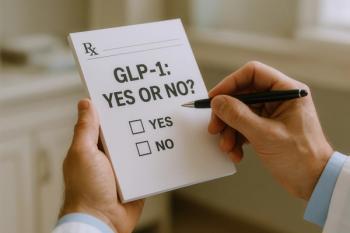
Experts Report Need for Framework to Address CNS Immune-Related AEs Resulting From ICI Treatment
According to the speaker, the complexity of immune-related adverse events resulting from immune checkpoint inhibitors requires a lot of collaborative discussion between patients and providers.
During a presentation at the American Academy of Neurology 2024 Annual Meeting in Denver, Colorado, James Hillis, MD, director of Clinical Operations at Massachusetts General Hospital & Brigham and Women’s Hospital, Center for Clinical Data Science, and Instructor of Neurology at Harvard Medical School, discussed the need to recognize a framework when diagnosing or classifying central nervous system (CNS) neurologic immune-related adverse events (AEs) resulting from treatment with immune checkpoint inhibitors (ICIs). Additionally, he highlighted approaches that could be used to treat these AEs.
First, Hillis noted that it is important to consider that ICIs can be used in combination with other cancer treatments, so providers must be able to determine whether AEs are a result of the ICI or the additional treatments. Additionally, ICIs have long half-lives. For example, nivolumab has a half-life of approximately 25 days; however, immune-related AEs will likely not occur immediately after the administration of an ICI. Similarly, Hillis noted that when treating patients, the treatment needs to be thought of over the course of weeks to months—rather than days—because ICIs may continue to be present in a patient’s system.
Four different immune-related CNS AEs are meningitis, encephalitis, demyelinating syndromes, and vasculitis, and when treating these AEs, Hillis said that the 2 important things to determine are whether a neurologic immune-related AE is suspected at all—and if the answer is yes, whether the AE is CNS or peripheral nervous system (PNS) immune-related—and whether the timing is consistent with an immune-related AE. If an immune-related AE is apparent, knowing the severity (or grade) and level of diagnostic surgery is essential to deciding what treatment may be best for the patient.
According to research, most immune-related AEs occur earlier in treatment, within the first 6 months of initiation or switching between ICIs. However, they can occur at any time during or after completing treatment. Additionally, most symptoms present within 12 months of the last ICI and may continue to build.
To further detail cases of immune-related AEs, Hillis highlighted a couple epidemiologic and demographic papers. The first study he mentioned found 3619 neurologic cases (approximately 7%) out of approximately 50,000 ICI-related reports. The study found that encephalitis and myelitis were the most common CNS immune-related AEs and had a higher number of cases than the remaining AEs combined. Additionally, the 4 AEs had occurred within 1 to 1.5 months of the initial administration of ICIs; however, demyelinating disorders were slower in onset, and were more likely to occur after about 4 months.
Furthermore, the second study Hillis referenced evaluated 64 patients with neurologic AEs of which 52 had CNS involvement. However, Hillis noted that there is a selection bias, which means that there are likely more patients who had CNS-related AEs.
“…the first point that I want to make here is that CNS immune-related AEs occurred with various ICIs, so it's not that there's actually 1 particular type that causes CNS immune-related AEs. Ultimately, all the different types can cause them,” said Hillis during the presentation. “And then the next point here is that CNS immune-related AEs had a mortality of between 13 and 26%, similar to…PNS immune-related AEs.”
Hillis continued by noting that approximately 33% of patients experienced non-neurologic immune-related AEs, and that a variety of treatments‑including ICI discontinuation and immunomodulatory agents—were used. Despite the improvements seen in treatment, the mortality rate was rather high and was approximately 40%; however, according to Hillis, just under half of this population had neurologic immune-related AEs contributing to their death.
“To move on to the treatment of immune-related AEs—and 1 of the things that I find conceptually fascinating—is that typically, we think of…medication [AEs] as being…negative and being something that we don't want to have happen. But here, there's actually the paradoxic element, in the sense that if you're having an immune-related AE, it shows that the immune system has actually been activated enough to cause these,” said Hillis during the presentation. “…[there is] a lot of evidence that suggests that people who have immune-related AEs have actually had an equal—if not better response—to the immunotherapy [they are receiving].”
When treating immune-related AEs, Hillis explained patients who are experiencing grade 1 symptoms should be monitored for worsening severity if continuing ICI therapy. Patients with grade 2 AEs should temporarily pause ICI therapy and receive corticosteroids depending on the toxicity. Additionally, there are data that suggests no difference in overall survival or time to treatment failure resulting from immune-related AEs or steroid use, and, according to Hillis, can be a positive indication of the immune system’s activity.
Further, other data also suggested the use of second-line immunosuppressants can decrease both overall survival and progression-free survival, and the combined use with steroids potentially worsening outcomes; however, the reason is not currently known. Hillis explained that possible explanations include the severity of the immune-related AE that initially required the second-line treatment; whether the degree of immunosuppression has led to further complications in the patient; and for patients who are early on in their ICI treatment or history, meaning that these patients receive less of the ICI than others might.
“…in terms of retreatment after immune-related AEs, this decision to rechallenge patients with ICIs may be complex. Factors that may cause clinicians to lean away from rechallenge include severe or life threatening immune-related AEs, the requirement for prolonged or multiple immunosuppressants, and the history of long-term ICI therapy and/or patients with complete responses or prolonged clinical benefit,” said Hillis during the presentation.
Similar to the guidelines when treating immune-related AEs, Hillis said that patients who have experienced grade 2 symptoms may be rechallenged with ICI therapy if their signs have either resolved or are controlled with less than 1 daily 10 mg dose of prednisone or an equivalent. Additionally, patients with grade 3 or 4 immune-related AEs should be risk adjusted based on the anticipated benefit with therapy versus the potential for toxicity.
“In summary…a framework for diagnosing and classifying neurologic immune-related AEs can assist with deciding [what] treatment strategy [to use]. The decision to treat immune-related AEs is multifactorial, and includes consideration of oncologic and neurologic implications, and it is critical to make any decisions together with a patient's oncologist,” said Hillis at the presentation’s conclusion.
Reference
Hillis, J. Neurologic Complications of Checkpoint Inhibitors: Checkpoint Inhibitor-Associated Central Nervous System Complications. Presented at: American Academy of Neurology 2024 Annual Meeting; Denver, Colorado. April 13-18, 2024.
Newsletter
Stay informed on drug updates, treatment guidelines, and pharmacy practice trends—subscribe to Pharmacy Times for weekly clinical insights.





















































































































































































































